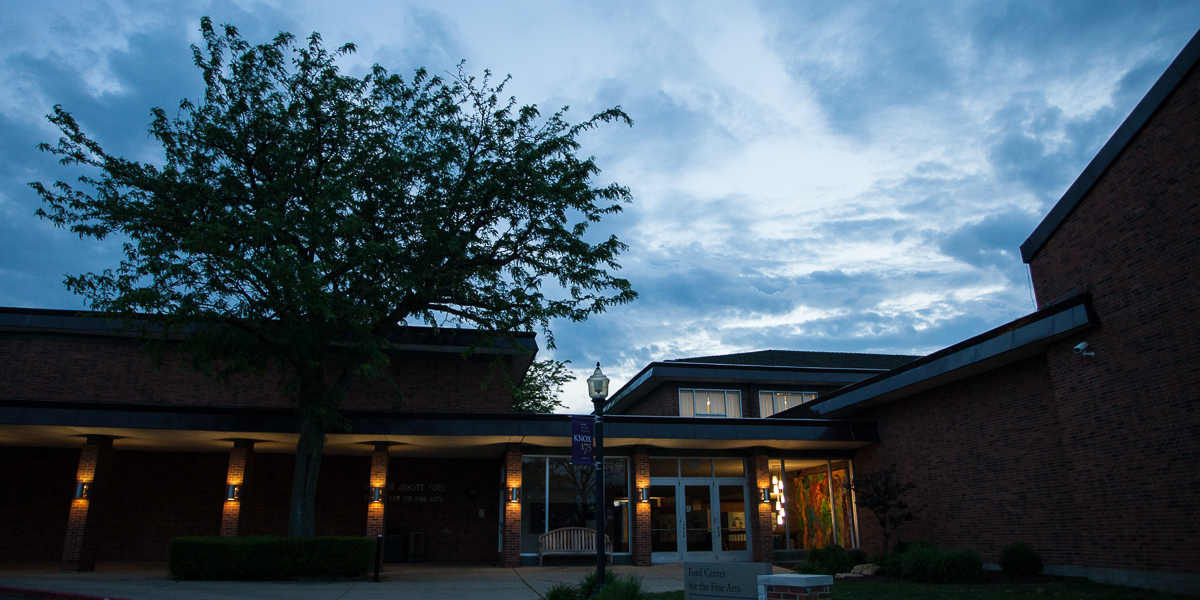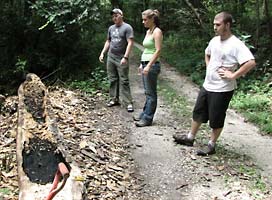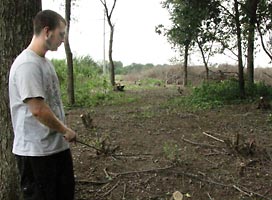

Venture Boldly

Adriana Colindres
Features Editor
2 East South Street
Galesburg, IL 61401

Three Knox College students just wrapped up their summer jobs as stewards at the Green Oaks Biological Field Station, a research and recreation area about 20 miles east of the Knox campus.
Individuals who are chosen for the stewardship program -- now in its second year -- work for 12 weeks to maintain and improve the 704-acre property, which consists of streams and lakes, uncut native forests, second-growth forests, and restored prairies.
For 2010, the stewards focused on removing invasive plant species. That is a key component of the ongoing prairie-restoration effort at Green Oaks, where the goal is to recreate the landscape as it looked a couple of hundred years ago.
The stewards were:
Eric Ballard of Albuquerque, New Mexico. An environmental studies major, he is scheduled to graduate from Knox in June 2011.
Helen Bartlett of West Lafayette, Indiana. A 2010 Knox graduate, she has a major in environmental studies and a minor in gender and women's studies.
Quinn Palar of Des Moines, Iowa. A 2009 Knox graduate, he has a major in environmental studies and a minor in biology. He was selected for Knox's post-baccalaureate fellowship program and served as a program assistant for Green Oaks Term in spring 2010.
Before becoming stewards, the trio participated in Green Oaks Term, a 10-week academic program in which a dozen Knox students live on the Green Oaks property while taking classes in subjects such as art and natural history.
"I absolutely loved it, and I fell in love with Green Oaks," Bartlett said. "I hope that my future career is in conservation, so this is a good way to get experience. I'm definitely very interested in prairie conservation."
As stewards, Ballard, Bartlett, and Palar received stipends and lived on the Green Oaks property. Here's a closer look at how they spent their summer.
Q: What kind of work did they do?
A: After breakfast every weekday, the stewards typically wielded chainsaws, axes, and other tools for four or five hours as they cleared the land of two types of invasive plant species: black locust trees and autumn olive shrubs. The fast-growing plants are labeled as "invasive" because they crowd out other species and "lower the biodiversity of the area," Palar said.
The stewards then dragged the chopped-down plants into brush piles in the woods, and they sprinkled rye seed in the newly cleared areas. Some rye grass has begun to sprout.
Every couple of weeks or so, they also walked along the trails at Green Oaks and removed fallen tree limbs or other debris that blocked the paths.
Q: Did they make much headway in getting rid of invasive plant species?
A: Yes. They focused their efforts on sectors of the Green Oaks property with the most severe infestations of black locusts and autumn olives. Palar compared the process to "doing triage."
"You definitely see the progress as it happens," Ballard said. An area "goes from being this crazy, tangled mess to an expanse that you can actually move through."
Bartlett added: "It's generally pretty satisfying work."
Shortly after starting as stewards, Ballard, Bartlett, and Palar tried to keep count of how many black locusts and autumn olives they were removing. But they lost track after 200 or so.
"It's never been about the number," Ballard said. "It's been more about just doing it."
Q: What else did the stewards do at Green Oaks?
A: To fulfill the educational component of the stewardship program, they compiled a guide to help others identify the major invasive species at Green Oaks. The photo-illustrated guide will explain how those species gained a foothold on the property, how they affect the ecosystem, and how they can be removed.
 During off-hours, the stewards were free to hike, fish, and swim on the Green Oaks property. They also pursued some self-designed projects. For example, they crafted a "living bench" out of leftover sod.
During off-hours, the stewards were free to hike, fish, and swim on the Green Oaks property. They also pursued some self-designed projects. For example, they crafted a "living bench" out of leftover sod.
"We haven't had to water it at all, and it is thriving with several species of plant," Palar said.
In a more complicated undertaking, the stewards began the process of building a canoe from scratch, using only hand tools. First, they used a two-person saw to cut down a dead cottonwood tree. Then, they set fire to portions of the tree to hollow it out and create space for passengers. "It's really, really labor-intensive," Palar said.
Q: What, if anything, surprised them about the experience of being a Green Oaks steward?
A: A native of the Southwest, Ballard initially thought of the Midwest as merely "a bunch of flat cornfields," but he has developed an appreciation for the terrain. "I've surprised myself at how much I feel attached to the prairie and to the small-town Illinois kind of culture," he said.
Bartlett said she didn't expect three people would be able to accomplish as much as they did in such a short span of time. "We've actually made a very significant difference in Green Oaks," she said. "It looks a lot different than it did when we got here in the beginning of the summer."
Published on August 30, 2010